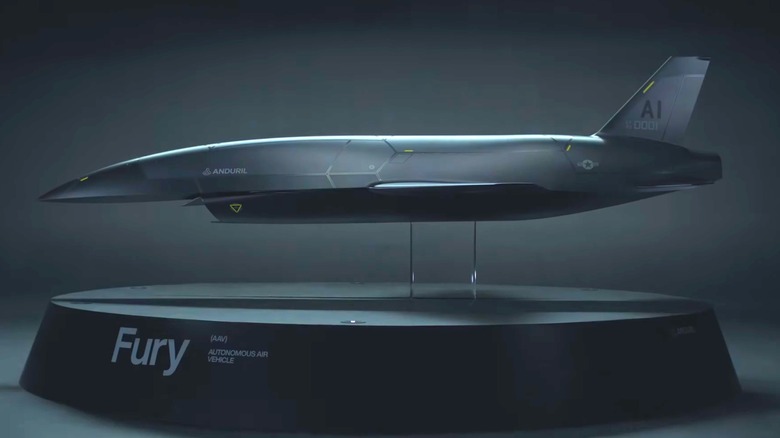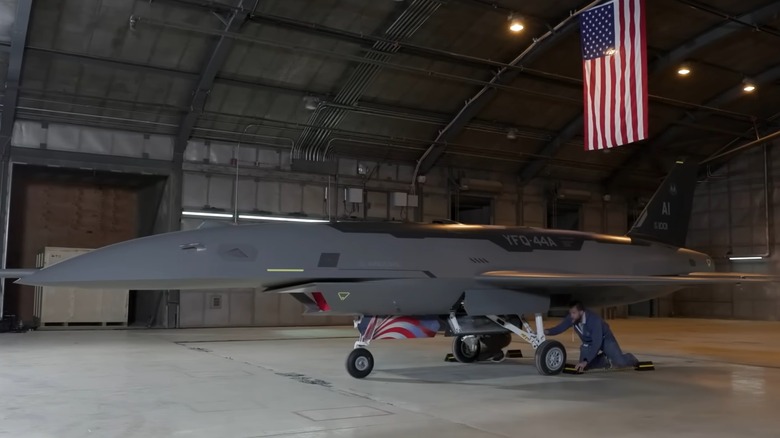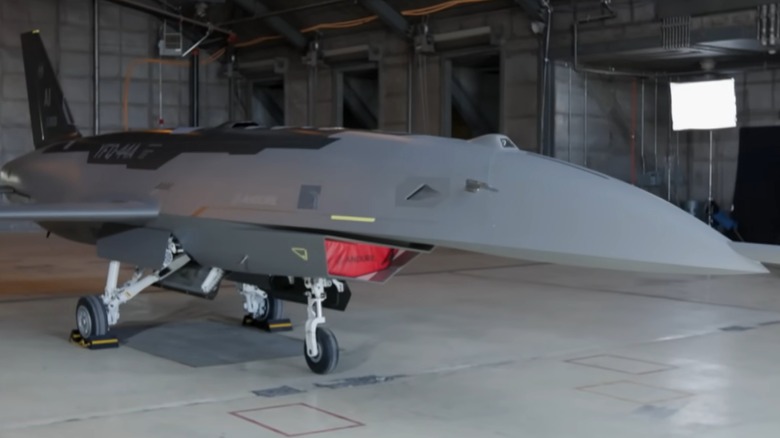Fury: America's New Superweapon Is A True Technological Marvel
The United States is the premier user of unmanned aircraft systems (UAS) as well as other drones, and has been for decades. Hunter-killer drones have changed warfare in the 21st century, and Anduril Technologies is working to change things up once more with the introduction of Fury. This is a high-performance, multi-mission group 5 autonomous air vehicle (AAV). A group 5 UAV is any drone that weighs more than 1,320 pounds, can fly over 18,000 feet above mean sea level, and can operate at any airspeed. Other examples of group 5 UAS are the MQ-9 Reaper and the RQ-4 Global Hawk.
The Fury hasn't been selected for procurement yet, but it's a step ahead of those drones, essentially being a fighter jet without the pilot. Adding an uncrewed ability to existing fighter jets is nothing new, as the military uses older F-16s for autonomous testing, but the Fury is built from the ground up as an autonomous combat aircraft.
Anduril has been working on the Fury since before 2023, and the first images of it were revealed to the world in a "60 Minutes Overtime" special in May 2025. The plan is to mass produce the aircraft if the U.S. Air Force selects it as a new weapons system. Should that happen, the unfriendly skies could soon be filled with deadly fighters operating without pilots, which opens the door for high-G maneuvers and other benefits without endangering any U.S. military operators.
The YFQ-44A Fury AAV
"Fury" is an internal Anduril name for the aircraft and not its designation, which is YQF-44A during development. Should it be selected by the Air Force, this will likely change. The Fury isn't as large as a standard fighter because it doesn't have to be, as it lacks a cockpit and the equipment needed to sustain a pilot. Instead, it measures about half the size and dimensions of an F-16 — one of the most commonly used fighter jets – with swept wings and external hardpoints for weapons.
Anduril naturally has some targeted performance parameters for Fury, including a service ceiling up to 50,000 feet and achieving speeds around Mach 0.95 (729 mph). Ideally, it will be able to perform up to +9 Gs at the highest and down to -3 Gs for short periods of time with sustained operation at +4.5 Gs. For comparison, some fighters can sustain 6 Gs with brief operation up to 10 or 12, but this is harmful to the pilot and can cause permanent physical injury, thus, it's rarely done.
The aircraft measures 20 feet in length with a 17-foot wingspan. It's outfitted with a commercial business Williams FJ44-4M turbofan engine. Using a commercial and readily available engine makes it possible for production to begin rapidly, which is Anduril's goal in Fury's potential acquisition by the Air Force. It features two hardpoints that can carry two AIM-120 AMRAAM missiles for air-to-air combat, though its loadout could change as development progresses and mission requirements change.
The World's First Autonomous Fighter Jet
The Fury's development is part of the Air Force's Collaborative Combat Aircraft (CCA) program, which envisions piloted aircraft flying in conjunction with autonomous drones. The Fury uses Anduril's Lattice Artificial Intelligence software so that it can be programmed to operate under certain conditions while the AI makes adjustments for identifying, selecting, and engaging targets. Ideally, at least one Fury would fly alongside something like the advanced F-35 Lightning II. Should it find a target, the Fury would engage beyond the F-35's range, ensuring the safety of the piloted aircraft.
This is a technological leap forward that has been the stuff of both dreams and nightmares for years. Creating an autonomous killing machine has its detractors, but Anduril's CEO, Brian Schimpf, assures that the system is intelligent, unlike a tank mine. Fury will be able to identify potential targets and engage, but a human can always step in and either trigger its kill switch or alter its target parameters.
A benefit to proceeding with the Fury is that building and operating one is cheaper than a traditional piloted aircraft. Parts like the landing gear can be machined in any shop in America. Other items are easier to machine than parts found on advanced fifth-generation fighters. That said, Anduril hasn't revealed the aircraft's cost, though estimates place it between the $25 and $30 million range. That's significantly cheaper than an F-35, and having a robotic wingman would only increase a manned fighter's survivability and lethality.


